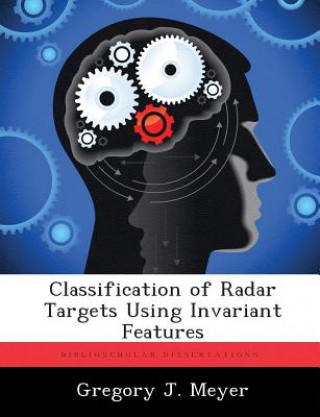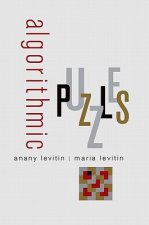
Kód: 08244431
Classification of Radar Targets Using Invariant Features
Autor Gregory J Meyer
Automatic target recognition (ATR) using radar commonly relies on modeling a target as a collection of point scattering centers. Features extracted from these scattering centers for input to a target classifier may be constructed ... celý popis
- Jazyk:
 Angličtina
Angličtina - Väzba: Brožovaná
- Počet strán: 108
Nakladateľ: Biblioscholar, 2012
- Viac informácií o knihe

Mohlo by sa vám tiež páčiť
-

Bodies, Sports and Social Problems
204.82 € -

Cyka Blyat! (or Suka Blyat?): Everyday Russian Slang and Curse Words
20.65 € -

Demon Slayer: Kimetsu no Yaiba, Vol. 7
9.40 € -18 % -

Dragon Tarot
23.20 € -4 % -

High-Rise Invasion Omnibus 1-2
16.56 € -22 % -

Blame! 2
31.28 € -13 % -

Ford Transit Diesel Service And Repair Manual
33.94 € -14 % -

Comets
166.58 € -12 % -

Doghead
21.16 € -13 % -

Pathways: Reading, Writing, and Critical Thinking 2 with Online Access Code
40.79 € -

Official IELTS Practice Materials 2 with DVD
11.03 € -

Kebra Negast
29.44 € -6 % -

Algorithmic Puzzles
49.69 € -

Your Soul Contract Decoded
16.86 € -21 % -

Kurz zvárania ručne elektrickým oblúkom obalenou elektródou
12.57 € -13 % -

Bautechnischer Brandschutz
51.94 € -

Erec
21.87 € -

Coma
13.28 € -

Die Struktur des Bankwesens als Gegenstand wirtschaftsstatistischer Analyse.
64.31 € -

Běhej se psem
11.95 € -19 % -

LOLITA
20.95 € -5 %
Darčekový poukaz: Radosť zaručená
- Darujte poukaz v ľubovoľnej hodnote, a my sa postaráme o zvyšok.
- Poukaz sa vzťahuje na všetky produkty v našej ponuke.
- Elektronický poukaz si vytlačíte z e-mailu a môžete ho ihneď darovať.
- Platnosť poukazu je 12 mesiacov od dátumu vystavenia.
Viac informácií o knihe Classification of Radar Targets Using Invariant Features
Nákupom získate 172 bodov
 Anotácia knihy
Anotácia knihy
Automatic target recognition (ATR) using radar commonly relies on modeling a target as a collection of point scattering centers. Features extracted from these scattering centers for input to a target classifier may be constructed that are invariant to translation and rotation, i.e., they are independent of the position and aspect angle of the target in the radar scene. Here an iterative approach for building effective scattering center models is developed, and the shape space of these models is investigated. Experimental results are obtained for three-dimensional scattering centers compressed to nineteen-dimensional feature sets, each consisting of the singular values of the matrix of scattering center locations augmented with the singular values of its second and third order monomial expansions. These feature sets are invariant to translation and rotation and permit the comparison of targets modeled by different numbers of scattering centers. A Mahalanobis distance metric is used that effectively identifies targets under "real world" conditions that include noise and obscuration. In particular, eight targets of military interest are sampled in tenth-degree aspect angle increments to extract scattering centers, and 36 subclasses that encompass ten degrees are specified for each target. Each subclass is compressed to a nineteen-dimensional singular value feature set, and because the spatial distribution of the 100 nineteen-dimensional points in each subclass is approximately Gaussian, a mean and a covariance matrix represent each subclass.
 Parametre knihy
Parametre knihy
Zaradenie knihy Knihy po anglicky Society & social sciences Education
69.43 €
- Celý názov: Classification of Radar Targets Using Invariant Features
- Autor: Gregory J Meyer
- Jazyk:
 Angličtina
Angličtina - Väzba: Brožovaná
- Počet strán: 108
- EAN: 9781288334810
- ISBN: 9781288334810
- ID: 08244431
- Nakladateľ: Biblioscholar
- Hmotnosť: 209 g
- Rozmery: 246 × 189 × 6 mm
- Dátum vydania: 21. November 2012
Obľúbené z iného súdka
-

Oxford IB Diploma Programme: IB Economics Course Book
62.27 € -

OET Preparation
10.42 € -

Cambridge IGCSE (R) & O Level Complete Physics: Student Book Fourth Edition
38.75 € -

Business Partner B2 Workbook
16.86 € -4 % -

Business Partner B1 Workbook
17.48 € -10 % -

Imagine If...
10.93 € -24 % -

OET Reading Subtest Preparation
12.77 € -7 % -

Vol 2 Blackletter Lettering Adventures
26.99 € -

AS & A Level Maths For Dummies
19.62 € -18 % -

CompTIA Security+ Review Guide - Exam SY0-601
26.37 € -20 % -

Amazing Autistic Brain Cards
42.02 € -

Hanbo Jutsu: Use of Hanbo, Cane and Walking Stick for Self Defense
11.65 € -

Embodied Teen
21.77 € -17 % -

Blue Book of Grammar and Punctuation: An Easy- to-Use Guide with Clear Rules, Real-World Examples , and Reproducible Quizzes, Twelfth Edition
16.97 € -20 % -

Positive Discipline Tools for Teachers
18.50 € -3 % -

Oxford IB Diploma Programme: IB Theory of Knowledge Course Book
57.97 € -

Oxford IB Study Guides: Economics for the IB Diploma
44.07 € -

Speed and Accuracy: Division
8.58 € -

GCSE Spanish Exam Practice Workbook (includes Answers & Free Online Audio)
7.97 € -10 % -

KS3 Maths 10-Minute Weekly Workouts - Year 7
8.07 € -9 % -

Vertical Academy
37.21 € -

Grade 9-1 GCSE Maths AQA Revision Question Cards - Higher
10.83 € -

Human Landscapes from My Country
27.91 € -4 % -

Cambridge IGCSE (R) & O Level Complete Chemistry: Student Book Fourth Edition
42.53 € -

Oxford IB Diploma Programme: IB Course Preparation Mathematics Student Book
41.10 € -

1000 TRIOS or gapped sentences for Cambridge Advanced and Proficiency Exams
25.04 € -

Business Partner B1+ Workbook
16.86 € -4 % -

(ISC) SSCP SG & SSCP Practice Test Kit, 3e
70.55 € -23 % -

Einkorn
20.75 € -21 % -

Czech Verbs
40.28 € -

Motivation and Reinforcement
46.93 € -

Pearson Edexcel International GCSE (9-1) English Language B Student Book
53.68 € -

Read Write Inc. Phonics: Red Ditty Book Bag Books (Mixed Pack of 10)
67.48 € -

Oxford International Primary Maths Second Edition: Practice Book 1
13.08 € -

Forensic Linguistics Articles
17.58 € -

Corrected Squares of The Book of Abramelin
611.32 € -

Exam Prep for Microeconomics by Pindyck & Rubinfeld, 6th Ed.
45.70 € -

KS3 Maths 10-Minute Weekly Workouts - Year 8
8.07 € -9 % -

Reading Mind - A Cognitive Approach to Understanding How the Mind Reads
24.02 € -20 % -

Ganzheitliche Sprachförderung
32.61 € -

Internet Protocol over Link-16
69.43 € -

Effect of Registration Errors on Tracking in a Networked Radar System
69.43 € -

Princeton Review SAT Premium Prep, 2021
45.91 € -

CEH v11 Certified Ethical Hacker Study Guide + Practice Tests Set
75.46 € -5 % -

10 Practice Tests for the SAT, 2021 Edition
33.94 € -

OCP Oracle Certified Professional Java SE 11 Programmer II Study Guide - Exam 1Z0-816 and Exam 1Z0-817
49.79 € -7 % -

Prepared
33.84 € -

Powerful Teaching: Unleash the Science of Learning
28.73 € -20 % -

Physics for You
57.46 €
Osobný odber Bratislava a 2642 dalších
Copyright ©2008-24 najlacnejsie-knihy.sk Všetky práva vyhradenéSúkromieCookies



 21 miliónov titulov
21 miliónov titulov Vrátenie do mesiaca
Vrátenie do mesiaca 02/210 210 99 (8-15.30h)
02/210 210 99 (8-15.30h)